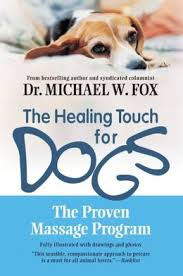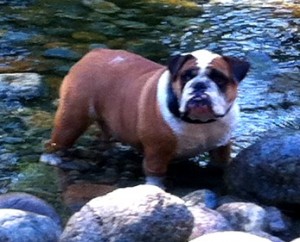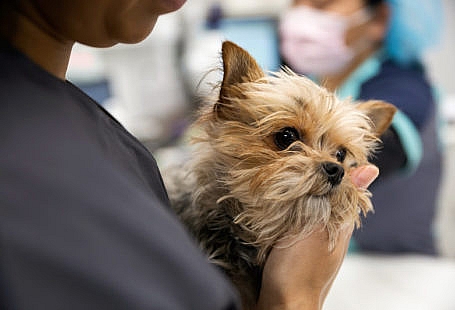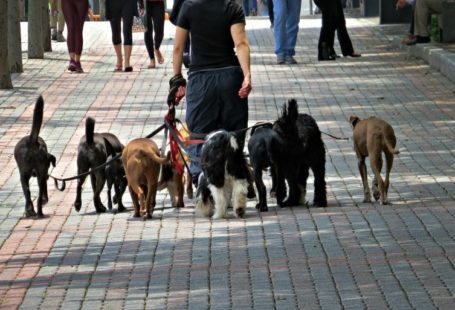These five simple do-it-yourself dog massage techniques are from certified canine bodywork practitioners. I interviewed them for an article on pet massage I wrote last year for alive magazine in Vancouver.

Healing Touch for Dogs: The Proven Massage Program by Michael Fox is one of the best resources on dog massage techniques. Below, I briefly describe a few easy do-it-yourself ways to massage your dog — but if your dog is sick or elderly, then you need to do more in-depth research on dog massage techniques. You might even consider hiring a certified canine bodywork practitioner.
Why Massage Your Dog?
Dog massage increases joint flexibility, softens tired or overused muscles, and enhances immunity by stimulating lymph flow and endorphin release. These do-it-yourself dog massage techniques promote tissue regeneration, pump oxygen and nutrients into vital organs, improv circulation, and even reduce post-surgery adhesions and swelling. Massaging your dog can ease neurological problems and help with palliative care.
If you massage your dog regularly, you’ll learn your dog’s body really well. This will increases the chances you’ll discover changes or abnormalities that may signal a health problem, and help you care for your dog before a disease or injury progresses too far.
Do-it yourself dog massage increases the connection between you and your canine. “Massage is one of the most intimate bonding activities I can do with an animal,” says Krista Olson-Madill of Paws4Serenity, who trained as a Caninology Canine Body Worker in Calgary, AB. “There is an incredible closeness and trust, and the energy shared is unmistakable. Sometimes I feel I’m one with the animal.”
5 Do-It-Yourself Dog Massage Techniques
Holding. Place your hands gently but securely on an area of your dog’s body, and hold still for a few minutes. “Holding is a great way to begin any session, as it allows your pet to warm up to your touch – literally and figuratively – before you start massaging in possibly unfamiliar ways,” says Olson-Madill. “Holding can also help desensitize ticklish or painful areas, such as paws, before you work on them.” She adds that holding helps us get into the right space to perform dog massage, because you want to be calm and centered before you begin massaging your dog.
Stroking. This do-it-yourself dog massage technique closely resembles petting. It’s a light, gentle touch that moves along your dog’s body. “Your strokes need to be fairly slow,” says Olson-Madill. “Faster motion will only excite and/or agitate your dogs. This is especially important for anxious dogs, and when working on any dog outside of its familiar environment.” She plays soft music during her dog massage sessions, because it’s relaxing and helps establish a slow rhythm for the strokes.
Effleurage. Use one hand after another in long, gliding strokes in quick succession. Vary your pressure from light to moderately deep. This turns into a continuous stroke down the length of your dog’s body, which has a positive effect on the circulatory system and muscle fibers. How could this do-it-yourself dog massage not be good for your cuddly canine?
Compression. This do-it-yourself dog massage technique involves a “pumping” action, using the palm or heel of your hand. It’s very effective for larger muscle groups. Compression is a type of dog massage that should not be done unless you know what you’re doing. This is why reading books on dog massage techniques is so important.

Dog Massage Oil
Friction. Using your fingertips, “anchor” the tissues against the bony structures beneath them, then make small movements back and forth. “You have to be very ‘tuned in’ to your dog to use friction,” says Olson-Madill. “This dog massage technique can be uncomfortable. It’s effective in reducing scar tissue, and is good to use on areas that have been warmed up and worked on. It’s also good to follow friction with effleurage.”
A wee bottle of Aroma Paws Lavender Massage Oil will help if your dog’s skin is dry or if you need a gentler, kinder massage.
Your dog will melt in your hands if you keep your pressure steady, slow, and calm. Your own breathing will become deep and regular, and you’ll find your shoulders dropping and relaxing.
Additional Do-It-Yourself Dog Massage Tips
What feels good on you, feels good on your dog. If you feel unsure about these do-it-yourself dog massage techniques, consult an animal massage practitioner. Generally, what feels good on you will feel good on your dog because our bodies are similar. For instance, dogs hold tension in their necks, shoulders and back – just like humans do.
Start with light dog massage. “Each animal has their own preference for how much pressure to use, and where they like it best,” says Carolyn Kutchyera of Backstretch Canine Massage, a certified canine/equine massage practitioner in Errington, BC. “Always start light, and increase pressure as you see the dog accepting the massage.”

Doesn’t Brioche look like he needs a dog massage?
Use your thumbs with do-it-yourself dog massage. Kneading with your thumbs is often welcome, depending on the size of your dog. “Target the large muscles of the neck, shoulders, and haunches. ‘Iron’ out the long back muscles on either side of the spine by running your fingers or thumbs slowly and firmly from the shoulder to the hind end. Some dogs like to be massaged all the way to the tail, and others prefer you to stop around the hip region. Don’t apply pressure directly to the bony areas on your dog’s body.”
Most dogs prefer to be massaged on one side of their bodies at a time. “Don’t forget the leg muscles!” says Kutchyera. “Use your thumb and tip of your forefinger to gently massage the muscles on the back and front of the muscles on the legs, and finish with another ironing technique from the lower leg upward.”
You can learn your dog’s anatomy by comparing it to your own body. “Find a bony landmark in your dog, such as the elbow – then find your own,” she says. “The muscling above the elbow in a dog is the same as on a human. The hock is equivalent to our heel – above our heel is the calf muscle. Above the hock is their calf muscle – and dogs love work on this as much as humans do.”
When to Avoid Massaging Your Dog
Do-it-yourself dog massage is healing in most circumstances, but Olson-Madill cautions against it if your dog is suffering from shock, fever, acute inflammation, skin problems, heat stroke, broken bones, ruptured discs, torn muscles, open wounds, surgical sites, or swollen lymph glands (which signal an infection in the dog’s body).
“If your dog seems to be feeling under the weather or is under acute veterinary care, hold off on the massage,” says Olson-Madill. “Most dog massage practitioners screen for these types of issues before beginning any work.”
Do you massage your dog? Researching and writing this article on do-it-yourself dog massage techniques has changed how I pet up my dogs.



